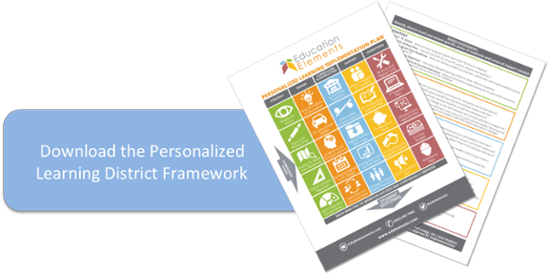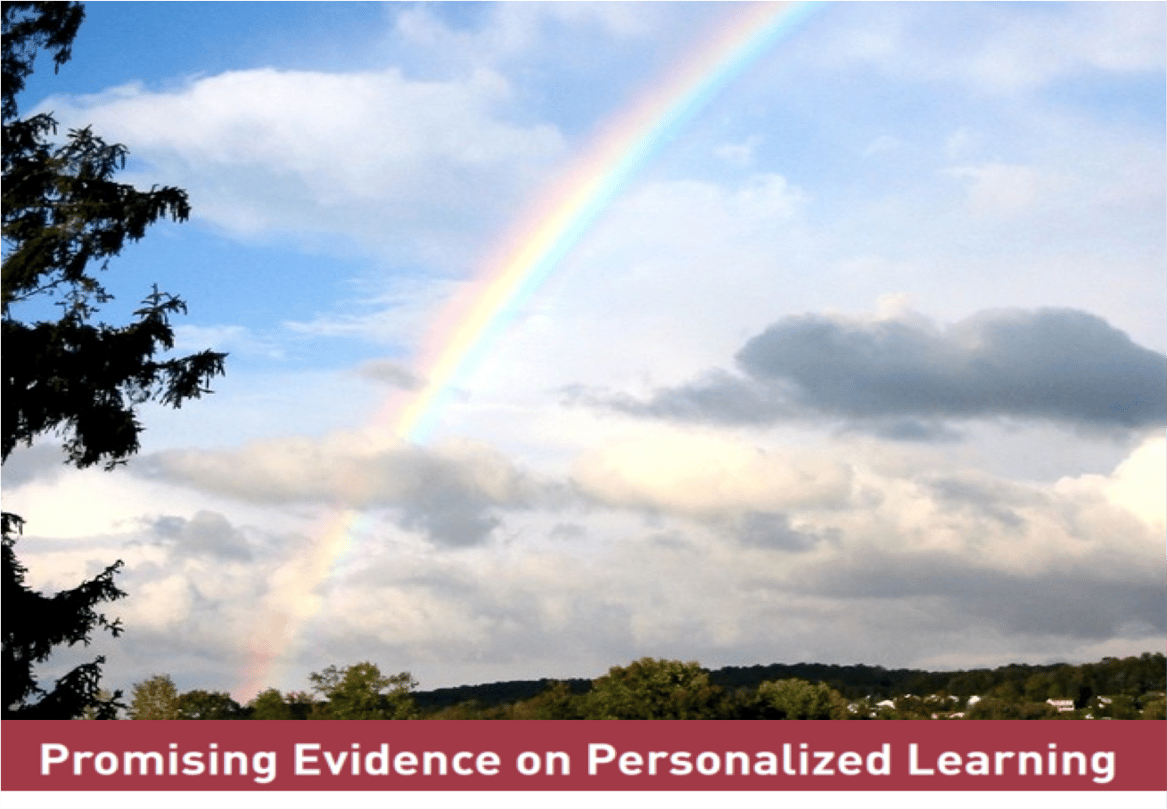
By: Nikki Mitchell & Scott Johns on November 23rd, 2015
The Results Are In, And This Time It's Personal: Promising Evidence On Personalized Learning
Personalized Learning | School Districts
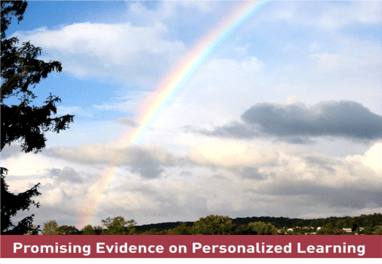
Personalized learning works, provided schools focus on data, student grouping, reflection, and creating flexible learning environments. Sound familiar? It certainly sounds like our most recent impact report, or maybe it reminds you of our personalized learning district framework, but this time we’re happy to announce that we’re not the ones saying it.
Last week, the RAND Corporation, in collaboration with the Bill and Melinda Gates Foundation, released Continued Progress: Promising Evidence on Personalized Learning, the second study in an ongoing series on the impact of personalized learning. The study applied rigorous methods to look at the achievement of 11,000 students at 62 public schools implementing personalized learning models with the support of the Gates Foundation.
We read this report with excitement. In addition to being one of the most statistically rigorous proofs of personalized learning yet, the report relates these academic outcomes to specific features of school implementations and proves that the methods we employ with school districts get results. While the Gates report draws its data from charter schools almost exclusively, our own experience working with traditional school districts is proof positive that personalized learning works for districts, too.
Alignment with our Results
The Gates Study found that “students attending these schools made gains in mathematics and reading over the past two years that were significantly greater than a comparison group made up of similar students selected from comparable schools.” Across all schools in the Gates study, a student who would have performed at the median would see an 11 percentile point gain in math and 8 percentile points in reading after 2 years in a personalized learning classroom. At the elementary school level, the effect was a 13 percentile point gain in math and 8 percentile points in reading.
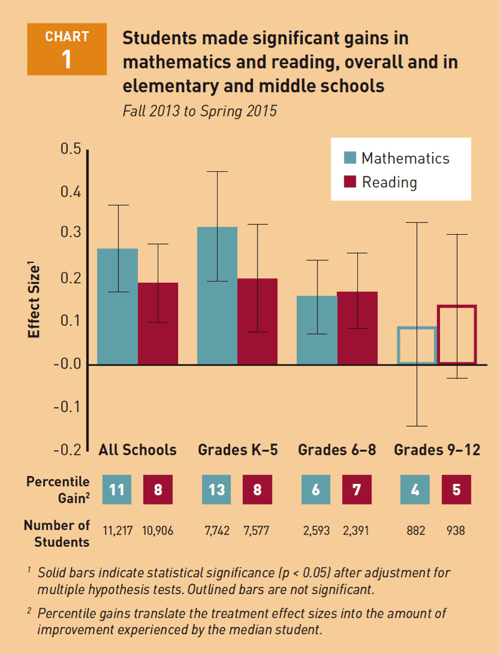
For comparison, our 2014-2015 Academic Impact Report found that students in personalized learning classrooms at Middletown City School District in New York outperformed their peers in the same district by 7% in math and 18.5% in reading in grades K-5. When we looked at 11,000 students from grades K-8 across 23 of our partner schools in traditional school districts, students outperformed national NWEA targets by 35% in math and 19% in reading and 6 out of 10 met or exceeded their national growth targets in reading and math.
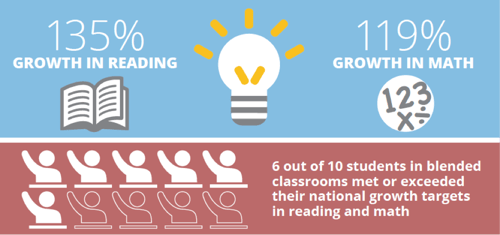
The Gates study also found that growth from personalized learning is cumulative. Schools in their second and third year of implementation continued to see gains over the prior year and “the longer students experience personalized learning practices, the greater their growth in achievement.”
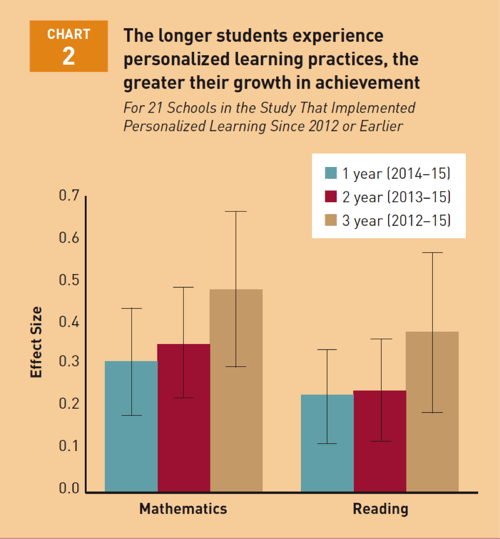
These findings confirm what we already see with our partner districts. For example, our Academic Impact report found that students at Horry County Schools in South Carolina experience similar cumulative benefits from personalized learning over time. In year two of personalized learning at Horry 14% more students in reading and 17% more in math met their NWEA MAPS target growth than in year one. Additionally, from year one to year two, 7th and 8th grade results improved by 4-5 times as much as 6th grade results. We believe this is because incoming 6th graders were in their first year of blended instruction, while rising 7th and 8th graders realized the cumulative benefits of two consecutive years of blended instruction.

Alignment with our own Methodology
The study identified a pattern of three core elements that are present in the most successful schools: (1) student grouping, (2) students discussing their data, and (3) learning spaces that support the personalized learning model.

For us, this pattern came as no surprise. Working with schools around the country for the last five years, we have acquired a solid understanding of “what works” in creating successful personalized learning environments. This experience led us to develop frameworks to assist schools in making this transition, including our Core Four, foundational principles that are essential for classroom success, and our Personalized Learning Implementation Plan, a systems-wide approach to support personalized learning. Not surprisingly, the elements identified by the Gates Foundation align with our own.
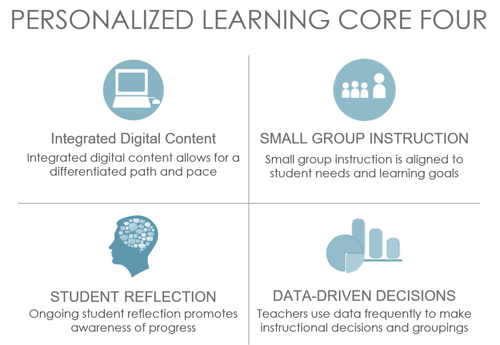
Student Grouping
One of our Core Four elements is “Small Group Instruction.” We employ this term to emphasize the need for teachers to target specific groups of students in purposeful, dynamic ways. Using data, these groups are created based on the needs and goals of students; the groups change on a frequent basis as student data changes. We have found that breaking down the whole-group structure found in traditional classrooms is key to personalized learning, and, as one client calls it, provides the “magic sauce” for student growth.
Students Discussing Their Data
A combination of two of our Core Four elements (“Data-Driven Decisions” and “Student Reflection”), we believe that providing students (and teachers) with meaningful opportunities to view data and reflect upon the learning process is essential for success. This includes setting individual goals, tracking data, and mentoring each student on a frequent basis to discuss the best path forward. Although far from simple to accomplish, we believe this use of data and reflection leads students to become self-directed learners who take ownership of their own learning. Like any other skill, developing self-direction takes time. Teachers must be familiar with strategies to support and promote self-direction, and students need to be taught how to take charge of their learning.
Creating Learning Environments that Support the Personalized Learning Model
Our work with schools clearly demonstrates the need to create a learning environment that supports a personalized learning model. For example, teachers might allocate instructional time based on student needs instead of a traditional bell schedule, arrange their classroom around stations instead of desks, or they might adopt a coteaching model. Similarly, the Gates report found that teachers at the most successful schools in their sample reported that “learning time was structured in a way that was flexible and responsible to student needs” and that they “think flexibly about how staff are used for instruction and student support.”
We have found that personalized learning is most successful when an entire school or district makes the shift towards personalized learning because the institution-wide support better facilitates the creation of flexible learning environments to support personalized learning. This support takes the form of systemic changes, including the creation of a clear vision, the development of a school- or district-wide rollout plan, the formation of a comprehensive communication plan, and the arrangement of classrooms and the school schedule. These changes, among many others, are paramount to the success of any personalized model. (See a recent blog post by our colleague, Keara Duggan, on our Personalized Learning Implementation Plan for creating district-level change to support personalized learning).
Our Reflections
Through this study, the Gates Foundation has made a definitive declaration: personalized learning works. But the foundation is far from alone in this announcement; this study joins a growing body of evidence reaching the same conclusion. In September, the Christensen Institute and Evergreen Education Group teamed up to publish 12 case studies of schools in which personalized learning is driving student growth. And as mentioned above, we published our own Impact Report stating similar results in September.
At Education Elements, we look forward to continuing to work alongside schools and districts ready to implement this promising practice and through our work, continuing to do our part to prove that personalized learning gets results.
Photo Credit: FreeImages.com/Christian Carollo


